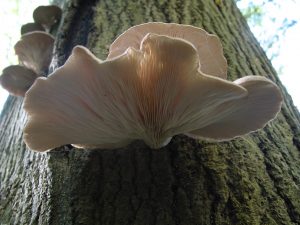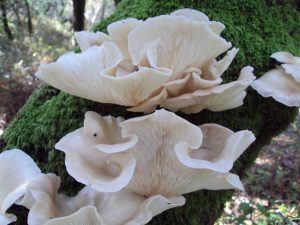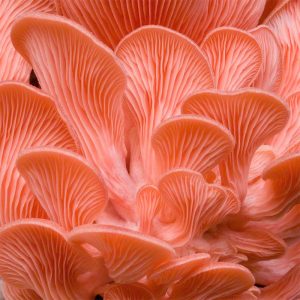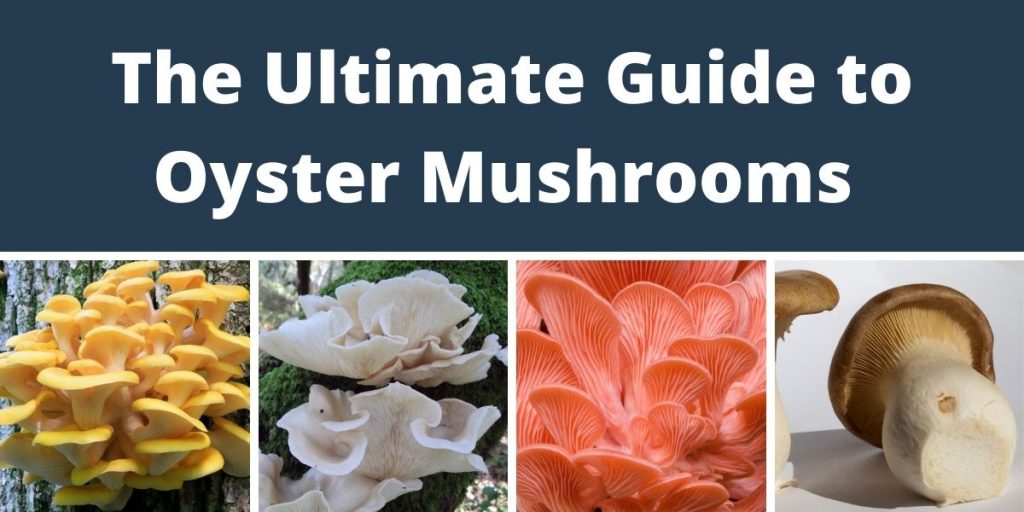“Oyster mushrooms” are the common name of one member of the Pleurotus genus—more loosely, all members of the genus can be called oyster mushrooms, with specific names like blue oyster and pink oyster. All of them are edible, and are sometimes said to taste vaguely like those oysters that live in the sea. The similarity is vague indeed, but most oyster mushrooms have a mild, pleasant taste. Some have a delicate, perfumed aroma. The flesh is tender, somewhat brittle, and firm without being chewy. Most are thin enough to cook quickly and evenly. Many species are also easy to grow. Many are credited with interesting medicinal benefits. It should be no surprised that oysters are, as a group, among the most popular edible mushrooms around.
Want to Grow Oyster Mushrooms? Here are the Best Oyster Grow Kits on the Market.
Oyster Mushrooms Benefits
The most obvious benefits of oyster mushrooms[i][ii] are culinary; they taste excellent and are considered a very healthy food. The other, more medicinal benefits are much less certain, but are supported by preliminary research Generally, the research applies to concentrated extracts, not the occasional mushroom meal). Note that although there appears to be broad overlap between the medicinal possibilities of each oyster species, the various oyster mushroom species are not biochemically identical and therefore do not have identical benefits, either. Most of the research has concerned Pleurotus ostreatus, the original oyster mushroom.
Nutritional Benefits
According to the USDA, a cup (86g) of uncooked oyster mushroom (P. ostreatus, presumably) has 5.2g of carbohydrate, 2.9g of protein, 2g of fiber, and just 0.3g of fat. What does that mean?
First, note that the USDA specified a cup of raw mushrooms, but oyster mushrooms should not be eaten raw. Mushrooms, being mostly water by volume, shrink significantly during cooking, so this is really much less than a cup of food.
Second, it all adds up to just 28 calories, mostly from complex carbohydrates. One of the most important nutritional benefits oyster mushrooms provide is that they add a lot of flavor and texture without adding a lot of calories to a meal.
Third, although almost a third of those calories are from protein, that doesn’t add up to a lot of protein; oyster mushrooms, like most mushrooms, are mostly water, making it impossible to eat enough to add up to a major protein source, unfortunately.
Oyster mushrooms are a good source of niacin and riboflavin, though, and provide smaller but still meaningful amounts of several other vitamins and minerals.
Medicinal Benefits
In preliminary studies, oyster mushroom extracts taken over a period of weeks might be able to strengthen the immune system. In samples of cultured cells (that is, not inside a living subject), oyster extract slowed the growth of certain kinds of cancer. Some studies suggest an ability to help control blood sugar in diabetics. Eating oyster mushrooms (as opposed to taking extracts) regularly might help lower cholesterol. Oyster mushrooms also contain antioxidants that have a protective effect on the body. They also produce an effective antibacterial substance, though whether this works like an antibiotic when eaten seems unclear so far.
Want to Grow Oyster Mushrooms? Here are the Best Oyster Grow Kits on the Market.
Identification
Oyster mushrooms are, as a group, wood-decayers (though, interestingly, they also hunt and eat nematode worms). Most either have no stem and attach directly by their side to the substrate or have a very short, off-center stem—but unlike the bracket fungi, they have gills and soft, tender flesh. Many are white or gray, but there are brightly-colored varieties as well. Unlike in many mushroom groups, spore color varies from one species to the next and can’t be generalized. Most oyster mushroom species share the same characteristic (though subtle) scent, but it’s hard to describe the scent except to say that it’s “oyster-mushroomy.” Most species fruit in clusters, and large flushes can appear from downed wood quite suddenly.
Look-alikes
Oyster mushrooms are not the only shelf-like fungi with gills and soft flesh; species from multiple, unrelated families have all converged on the same basic appearance. Mycologists refer to the whole group as “pleurotoids[iii],” which basically means “oyster-mushroom-like.” There is no fool-proof way to differentiate all oyster mushrooms from all other pleurotids, and in fact not all oyster mushrooms are pleurotids—the king oyster, for example, is not. Foragers must simply learn what the oyster mushroom species in their area look like.
Some oyster mushroom species are also variable and can overlap in appearance with each other. It’s usually possible to work out the correct identification, though.
It’s also worth noting that “looking like” is subjective and depends on the observer’s experience level. To a raw beginner, unused to noticing key differences in mushroom anatomy, almost any mushroom can look like any other, while to an experienced mycophile, subtle differences jump out as obvious—this is one reason beginners should not forage without expert guidance. There is no shame in being a beginner, but if plurotoids and non-plurotoids (say, chanterelles, jack-o-lanterns, or bracket fungi) still look alike, it’s not time to go foraging alone yet.
Want to Grow Oyster Mushrooms? Here are the Best Oyster Grow Kits on the Market.
Types of Oyster Mushrooms
There are dozens of different types of oyster mushroom species. What follows are several of the best-known and most-distinct species. Many of the others are very similar to one or another of those on the following list.
Oyster Mushroom (Pleurotus ostreatus)

This[iv] is the species most commonly meant when people refer to “oyster mushroom” without any adjective. It’s also sometimes called tree oyster or pearl oyster. It comes in all the classic oyster mushroom shapes, from fan-shaped with no stem to round with a short, almost central stem. The top of the cap can be anywhere from almost white to dark gray-brown. Older specimens may be buff-color. Spores can be white, yellowish, or lilac. In the wild, this species eats any kind of dead wood, though it prefers hardwoods (if seen fruiting from a living tree, the fungus is probably feeding on an area of dead wood only). It grows across much of the temperate and sub-tropical world and can fruit almost any time except the summer. A subspecies (Pleurotus ostreatus var. Columbinus) with a bluish-gray cap and a longer, more distinct stem is commonly called the blue oyster.
Phoenix Oyster (Pleurotus pulmonarius)

The phoenix oyster[v] looks almost exactly like the “true” oyster or pearl oyster. The difference is it’s paler, often smaller, and usually has a stem. It lives in parts of North America where the pearl oyster does not. It happily eats any hardwood, living or dead, and fruits mostly in the summer (when pearl oyster does not). Spores are white, gray, or lilac. It has an almost exact look-alike (P. populinus) that shares the same range but eats only aspens and cottonwoods and has larger spores.
Golden Oyster (Pleurotus citrinopileatus)

Golden oysters[vi] have, as the name implies, yellow caps—the shade is usually more buttercup than gold, though. They are white otherwise, with pinkish spores. Unlike many oyster species, they usually have a round cap and a centrally-attached stem. They fruit in clusters, growing from dead wood, usually hardwoods. They are not native to the Americas, but do grow widely across Eurasia.
Pink Oyster (Pleurotus djamor)

The aptly-named pink oyster[vii] is pink all over; even its mycelium and spores are pink. Unfortunately, the brilliant color fades to mere pinkishness when cooked. The caps are large, wavy, thin, and somewhat brittle. There is a short stem set off to the side slightly. This species grows wild across much of the tropical parts of the world, preferring hot weather. It can be cultivated in more temperate areas, but even cultivated it is mostly available in the summer. The shelf-life is very short—it has to be eaten (or preserved in some way) within a day or so of harvest.
The King Oyster (Pleurotus eryngii)

The king[viii] earns its name not only by being the best-tasting member of its genus, but also by being among the biggest. Its shape is unusual, for an oyster, since it has a relatively long, thick stem and a relatively small cap. The stem is usually centrally attached or nearly so. The cap is tan to brown. Everything else is white. The spores are white. This species is native to the Mediterranean region and to southeast Asia as far as India. It is also widely cultivated. Another unusual feature is that it can feed parasitically on herbaceous plants, something most members of its genus don’t do.
Want to Grow Oyster Mushrooms? Here are the Best Oyster Grow Kits on the Market.
Frequently Asked Questions (FAQ)
Where Can I Find Wild Oyster Mushrooms (Where Do They Grow)?
There is no way to generalize about oyster habitats or range; each species has its own. Many are cultivated very widely, though, so the nearest place to find them could be in the grow-kit on your kitchen table.
When Is the Best Time to Harvest Oyster Mushrooms?
Again, the time to harvest from the wild depends on the species; there is an oyster mushroom species fruiting somewhere on the planet at every time of year. Cultivated oysters can usually be raised to fruit at any time, if their growing conditions are right.
What Do Oyster Mushrooms Taste Like?
Most oyster mushroom have a mild, perhaps faintly fish-like, taste and a tender, smooth texture (quite unlike that of shellfish). Both taste and texture vary slightly with species. Some are considered better than others, though the flavor is generally still a variation on the same theme.
How to Prepare and Clean Oyster Mushrooms?
Oyster mushrooms generally don’t require much cleaning. In any case, most mushrooms should not be washed because they absorb water easily and because some of the flavor could bleed off (as if they were being made into tea). Just brush away any clinging debris and check for bugs or other issues that might need to be cut away.
When preparing dried oysters, it’s not necessary to soak the mushrooms for an extended period—again, soaking mushrooms can lower their quality. Simply moisten the dried mushroom pieces and wait a few minutes, then check again. If necessary, add a little more moisture.
The basic way to cook oyster mushrooms is to cut or tear them into bite-sized pieces, then saute with garlic and black pepper in butter or oil until golden (of course, in more colorful species the color change may be hard to see). The mixture can then go on toast—for interesting variations, add chopped onion or cheese or both to the pan. Alternatively, the mushrooms can become the basics of a cream and wine sauce, or a cream-based soup, or a stir-fry. There are a lot of options.
Can You Freeze Oyster Mushrooms?
Yes, oyster mushrooms freeze well. They should be cooked first, preferably in butter. Frozen oysters will not last indefinitely; they can get freezer-burned if not used.
They can also be dried, either in a food dehydrator or, often, simply in ordinary air, provided there is plenty of air-flow. In fact, preventing oysters from drying (by storing them in plastic, for example) is a bad idea; dried oysters can be re-hydrated, but moldy oysters (as they will be if stored in plastic) can’t be un-molded. It’s best to either use them or preserve them within a few days.
Note that air-dried oysters, or dried oysters stored in humid air, will likely retain enough moisture to mold within a few weeks. For long-term storage, either freeze or dry thoroughly and store properly. But air-drying is good enough to extend the shelf-life long enough to make a few meals of the mushrooms.

My name is Austin Collins.
I've dedicated my life to Mushrooms.
I believe Mushrooms are the best kept secret when it comes to health and well being.
For that reason, I would like to share a company with you that in my opinion makes the best mushroom products on the market.
The company is called Noomadic Herbals, my favorite supplement they make is called "Mushroom Total".
I take their products every day and they have helped me think better and have more energy. Give them a try.
-Austin
References:
[i] Wong, C., Moore, M. (2020). Oyster Mushroom Nutrition Facts and Health Benefits.
[ii] Carson, T. (n.d.). Oyster Mushroom Health Benefits.
[iii] Kuo, M. (2005). Oysters: Pleurotid Mushrooms. MushroomExpert.Com
[iv] Kuo, M. (2017). Pleurotus ostreatus.
[v] Kuo, M. (2017). Plueurotus pulmonarius.
[vi] Kent, T. H. (2020). Pleurotus citrinopileatus. FloraFinder



